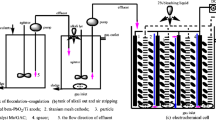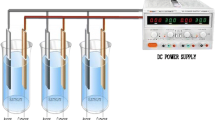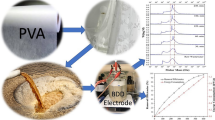Abstract
Centrifugal mother liquid (CML) is one of the main sources of wastewater produced during the production of polyvinyl chloride in chlor-alkali industry. CML is a typical poorly biodegradable organic wastewater, containing many kinds of refractory pollutants. Specifically, it contains dissolved refractory polymers, especially polyvinyl alcohol (PVA), which can pass though the biotreatment processes and clog the membranes used for further treatment. In this study, to ensure the CML applicable to biotreatment and membrane treatment, a novel efficient and mild technique, air-Fenton treatment, was employed as a pretreatment technique to improve biodegradability of the CML and to break down the polymers in the CML. Firstly, the technique was optimized for the CML treatment by optimizing the main parameters, including the dosage of ferrous sulfate, initial pH of the wastewater, [H2O2]/[Fe2+], aeration rate, reaction time, and temperature, based on removal efficiency of COD and PVA from the CML. Then, the optimized technique was tested and evaluated. The results indicated that under the optimized conditions, the air-Fenton treatment could remove 66, 98, and 55 % of the COD, PVA, and TOC, respectively, from the CML. After the treatment, biodegradability of the wastewater increased significantly (BOD/COD increased from 0.31 to 0.68), and almost all of the PVA polymers were removed or broken down. Meanwhile, concentration of the remaining iron ions, which were added during the treatment, was also quite low (only 2.9 mg/L). Furthermore, most of the suspended materials and ammonia nitrogen, and some of the phosphorus in the wastewater were removed simultaneously.



Similar content being viewed by others
References
Al Mubaddal F, Al Rumaihi K, Ajbar A (2009) Performance optimization of coagulation/flocculation in the treatment of wastewater from a polyvinyl chloride plant. J Hazard Mater 161:431–438
APHA (1995) Standard methods for the examination of water and wastewater, 19th edn. American Public Health Association, Washington, DC
Bautista P, Mohedano AF, Casas JA, Zazo JA, Rodriguez JJ (2008) An overview of the application of Fenton oxidation to industrial wastewaters treatment. J Chem Technol Biotechnol 83:1323–1338
Bing J (2012) Analysis on situations of China’s PVC industry in the year 2011. Polyvinyl Chloride 40:1–8 (in Chinese)
Cao G, Sheng M, Niu W, Fei Y, Li D (2009) Regeneration and reuse of iron catalyst for Fenton-like reactions. J Hazard Mater 172:1446–1449
Chen Q, Wu P, Li Y, Zhu N, Zhi D (2009) Heterogeneous photo-Fenton photodegradation of reactive brilliant orange X-GN over iron-pillared montmorillonite under visible irradiation. J Hazard Mater 168:901–908
Cheng H, Xu W, Liu J, Wang H, He Y, Chen G (2007) Pretreatment of wastewater from triazine manufacturing by coagulation, electrolysis, and internal microelectrolysis. J Hazard Mater 146:385–392
Chu X (2010) PVA degradation by a combined method of advanced oxidation pre-treatment and bio-degradation. Dissertation, Qingdao University of Science & Technology (in Chinese)
Clark WM, Cohen B (1923) Studies on oxidation-reduction. II. An analysis of the theoretical relations between reduction potentials and pH. Public Health Rep 38:666–683
Deng Y (2007) Physical and oxidative removal of organics during Fenton treatment of mature municipal landfill leachate. J Hazard Mater 146:334–340
Deng Y, Englehardt J (2009) Kinetics and oxidative mechanism for H2O2 enhanced iron-mediated aeration (IMA) treatment of recalcitrant organic compounds in mature landfill leachate. J Hazard Mater 169:370–375
Dong D, Song X, Hua X, Yuan M, Liang J, Guo Z, Liang D (2012) Relationship between COD and TOC of typical wastewaters in Jilin Province and mechanism and main influencing factor. J Jilin Univ (Earth Sci Ed) 42:1446–1455 (in Chinese)
Duesterberg CK, Waite TD (2006) Process optimization of Fenton oxidation using kinetic modeling. Environ Sci Technol 40:4189–4195
Duesterberg CK, Cooper WJ, Waite TD (2005) Fenton-mediated oxidation in the presence and absence of oxygen. Environ Sci Technol 39:5052–5058
Esplugas S, Gimenez J, Contreras S, Pascual E, Rodríguez M (2002) Comparison of different advanced oxidation processes for phenol degradation. Water Res 36:1034–1042
Fenton HJH (1894) LXXIII.—Oxidation of tartaric acid in presence of iron. J Chem Soc Trans 65:899–910
Finley JH (1961) Spectrophotometric determination of polyvinyl alcohol in paper coatings. Anal Chem 33:1925–1927
Gogate PR, Pandit AB (2004) A review of imperative technologies for wastewater treatment I: oxidation technologies at ambient conditions. Adv Environ Res 8:501–551
Herney-Ramirez J, Vicente MA, Madeira LM (2010) Heterogeneous photo-Fenton oxidation with pillared clay-based catalysts for wastewater treatment: a review. Appl Catal, B 98:10–26
Hu X, Wang X, Ban Y, Ren B (2011) A comparative study of UV–Fenton, UV–H2O2 and Fenton reaction treatment of landfill leachate. Environ Technol 32:945–951
Huang P (2007) Study on treatment of thermophilic PVC wastewater in aerobic moving bed biofilm reactor. Dissertation, Harbin Institute of Technology (in Chinese)
Jeffery GH, Basset J, Mendham J, Denny RC (1989) Vogel’s textbook of quantitative chemical analysis, 5th edn. Longman Scientific & Technical, Essex, pp 368–395
Kang YW, Hwang KY (2000) Effects of reaction conditions on the oxidation efficiency in the Fenton process. Water Res 34:2786–2790
Labunska I, Brigden K, Santillo D, Johnston P, Walters A (2008) Characterisation of wastewater discharges from chloralkali plants and associated chlorinated chemical production facilities in Spain. Greenpeace Research Laboratories Technical Note (12/2008), University of Exeter, Exeter
Lei L (2000) Advanced oxidation of polyvinyl-alcohol by the photo-Fenton reaction. Acta Sci Circumst 20:139–144 (in Chinese)
Li C, Chen Y, Chiou Y, Liu C (2007) Dye wastewater treated by Fenton process with ferrous ions electrolytically generated from iron-containing sludge. J Hazard Mater 144:570–576
Lin SH, Chang CC (2000) Treatment of landfill leachate by combined electro-Fenton oxidation and sequencing batch reactor method. Water Res 34:4243–4249
Liu F, Wang S, Liu X, Zhang Y (2010) Operation summary of PVC centrifugal mother liquid recycling. China Chlor-Alkal 2:41–43 (in Chinese)
Lopez A, Pagano M, Volpe A, Pinto ACD (2004) Fenton’s pre-treatment of mature landfill leachate. Chemosphere 54:1005–1010
Neyens E, Baeyens J (2003) A review of classic Fenton’s peroxidation as an advanced oxidation technique. J Hazard Mater 98:33–50
Pan J, Sun T, Li H (2007) Effects and mechanisms of inorganic anions in water on degradation of LAS by UV/H2O2 combination process. Environ Sci 28:2539–2543 (in Chinese)
Pignatello JJ, Oliveros E, MacKay A (2006) Advanced oxidation processes for organic contaminant destruction based on the Fenton reaction and related chemistry. Crit Rev Environ Sci Technol 36:1–84
Song Y, Li Y (2009) Reutilization of mother liquid of PVC and biological treatment technology. China Chlor-Alkal 1:36–39 (in Chinese)
Tan C, Gao N, Chu W, Li C, Templeton MR (2012) Degradation of diuron by persulfate activated with ferrous ion. Sep Purif Technol 95:44–48
Trapido M, Kulik N, Goi A, Veressinina Y, Munter R (2009) Fenton treatment efficacy for the purification of different kinds of wastewater. Water Sci Technol 60:1795–1801
Xiao Y, Chen Y, Zhang J, Zhao H, Sun C, Wu M (2001) Affecting factors and biodegradability in pretreating H-acid wastewater by Fenton’s reagent. Environ Chem 20:281–285 (in Chinese)
Xie B, Lv Z, Lv B, Gu Y (2010) Treatment of mature landfill leachate by biofilters and Fenton oxidation. Waste Manag 30:2108–2112
Yang Z, Xu Z, Gao W, Huang S, Song Y (2005) Study on the treatment of polyvinyl chloride industrial wastewater by membrane bioreactor. Water Purify Technol 24:21–23 (in Chinese)
Zhang B, Zhou Y (2003) The sizing pollution and environmental protection. Cotton Text Technol 31:17–20 (in Chinese)
Zhang S, Yu H (2004) Radiation-induced degradation of polyvinyl alcohol in aqueous solutions. Water Res 38:309–316
Zhang N, Lv M, Meng X (2001) The measurement of COD in Fenton system. J Harbin Univ Commer (Nat Sci Ed) 2:27–28 (in Chinese)
Zhang X, Lv Y, Jin Q (2003) Testing on treatment of emulsified wastewater from PVC production by conventional coagulation–filtration method. Ind Water Wastewater 34:47–49 (in Chinese)
Zhao D, Wei Y, Wang Y (2011) Treatment and use of PVC mother liquid. China Chlor-Alkal 5:11–13 (in Chinese)
Zhou T, Lu X, Wang J, Wong F, Li Y (2009) Rapid decolorization and mineralization of simulated textile wastewater in a heterogeneous Fenton like system with/without external energy. J Hazard Mater 165:193–199
Zhu Z, Niu Z, Gao X, Wang D (2011) Treatment of PVC wastewater through steam stripping combined with oxidation process. Chem Bioeng 28:77–80 (in Chinese)
Acknowledgments
This study was supported by the Major Science and Technology Program for Water Pollution Control and Treatment in China (no. 2012ZX07202009) and Jilin Environmental Protection Bureau (2009-19). The authors also thank three anonymous reviewers for improving the manuscript.
Author information
Authors and Affiliations
Corresponding author
Additional information
Responsible editor: Philippe Garrigues
Rights and permissions
About this article
Cite this article
Sun, Y., Hua, X., Ge, R. et al. Investigation on pretreatment of centrifugal mother liquid produced in the production of polyvinyl chloride by air-Fenton technique. Environ Sci Pollut Res 20, 5797–5805 (2013). https://doi.org/10.1007/s11356-013-1604-2
Received:
Accepted:
Published:
Issue Date:
DOI: https://doi.org/10.1007/s11356-013-1604-2




